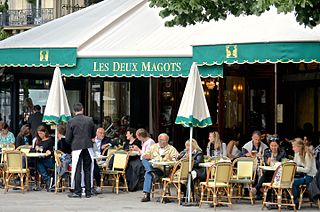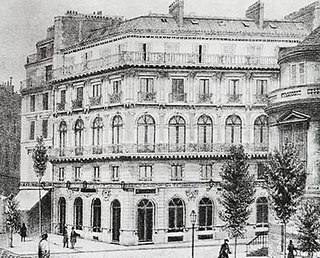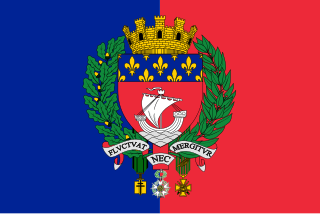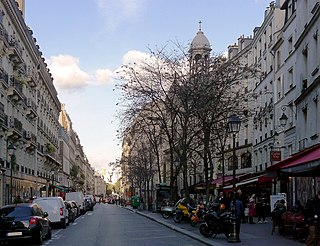

La Tour d'Argent (English: The Silver Tower) is a historic restaurant in the 5th arrondissement of Paris, France. It is located at 15 Quai de la Tournelle. It has a rating of one star from the Guide Michelin . [1]


La Tour d'Argent (English: The Silver Tower) is a historic restaurant in the 5th arrondissement of Paris, France. It is located at 15 Quai de la Tournelle. It has a rating of one star from the Guide Michelin . [1]
This section possibly contains synthesis of material which does not verifiably mention or relate to the main topic.(April 2024) |
The restaurant claims that it was founded in 1582, and that it was frequented by Henri IV, but offers no documentation to support these or other claims about its history. [2] The Quai de la Tournelle, where the restaurant stands, was not paved until 1650, before which it was "a slope, often flooded and almost always made inaccessible by mud". [3] The restaurant today is at the corner of the Rue du Cardinal-Lemoine , which did not exist until the end of the eighteenth century.
The restaurant does not appear in an 1824 list of "The principal restaurants, who are distinguished by the elegance of the decoration of their salons and by the number and the care taken with the dishes found there...". [4] In 1852, a metals dealer occupied number 15 Quai de la Tournelle, and a hairdresser and wood dealer number 17. [5]
Baedeker's 1860 guide to Paris describes the establishment's current location as "out of the way", while mentioning a restaurant associated with a low-cost "Hotel of the Tour d'Argent": "Between Notre Dame and the jardin des Plantes, on the Quai de la Tournelle, facing the bridge of this name, there is a little hotel and the restaurant Lecoq; Hôtel de la Tour d'argent, a bit out of the way, it is true, but well kept and cheap (room, 2 francs, beefsteak, 1 franc). Facing a swimming school, which has the advantage of not yet being encumbered and imprisoned by all the filth of Paris." [6]
The restaurant was owned in the 1890s and 1900s by Frédéric Delair, who began the tradition of presenting a numbered certificate to each person who ate the restaurant's signature dish, pressed duck. A dinner was held there for the Wright Brothers in 1906. [7] In 1912, the Terrail family bought the restaurant. It was operated first by André Terrail, then by his son Claude, who died in 2006 at the age of 88, and then by Claude's son André. [8]
In 1984, a branch was opened in Tokyo, in the Hotel New Otani. [9]
Since 1986, La Tour d'Argent has been a recipient of the Wine Spectator Grand Award. [10]
Until 1996, the Guide Michelin awarded the restaurant three stars. The rating was reduced to two stars in 1996, and to one star in 2006. [8]


Duck, especially the pressed duck, is the speciality (Canard à la presse, Caneton à la presse, Caneton Tour d'Argent, and recently renamed “Caneton de Frédéric Delair”). [11] The restaurant raises its ducks on its own farm. Diners who order the duck receive a postcard with the bird's serial number, now well over 1 million. [12] (Serial number #112,151 went to U.S. President Franklin Delano Roosevelt, #203,728 went to Marlene Dietrich, and #253,652 went to Charlie Chaplin). [13]
The restaurant's wine cellar, guarded around the clock[ citation needed ], contains more than 450,000 bottles whose value was estimated in 2009 at 25 million euros (£22.5 million). Some 15,000 wines are offered to diners on a 400-page list. [14] [15] During a routine inventory control in 2024, wine worth more than €1.5m was found to be missing from the wine cellar. [16]
The dining room has an excellent view of the river Seine and Notre Dame.
In Accidental Agent, A thrilling account of underground warfare in France , John Goldsmith, agent of the British Special Operations Executive, tells how after escaping his German SS captors at Hotel Continentale in the Rue de Rivoli, he was hidden in an upper-floor flat in the Tour d'Argent building that was occupied by Rumanian actress Madame Tantzy. [17]
In A Moveable Feast , Ernest Hemingway says that the Tour d'Argent rented some rooms and gave its lodgers discounts on the meals; also that a valet there used to sell English books left by the tenants. [18]
Marcel Proust mentions the restaurant three times in his novel À la recherche du temps perdu ( In Search of Lost Time ). For example, the haughty Mme Verdurin sniffs "The Tour d'Argent is not nearly as good as they make out". [19]
In a scene in the 1960 novel The Centurions where French prisoners of war are discussing the kinds of meals and cars they plan to buy with their backpay, an officer named Captain Verdier mentions that Lapérouse has been surpassed by Tour d'Argent in quality, a fact that he finds "most annoying". [20]
The restaurant inspired scenes in the 2007 Pixar movie Ratatouille, and received an "unexpected boost" from the film. [21]
Four episodes of Fuji TV's Iron Chef had chefs from the Paris and Tokyo branches as challengers. From the Paris branch, Bernard Leprince faced Iron Chef Japanese Komei Nakamura twice, with either chef winning once (Leprince won the initial meeting on the French Special at Chateau de Brissac with salmon as the theme, while Nakamura won the rematch in Tokyo with duck as the theme). Meanwhile, from the Tokyo branch, Tadaaki Shimizu bested Iron Chef French Hiroyuki Sakai with lobster as the theme, while Dominique Corby was the 300th challenger and battled Iron Chef Chinese Chen Kenichi to a draw with foie gras as the regulation theme and asparagus as the overtime theme.
One episode of Root into Europe (British comedy starring George Cole) was filmed in the hotel, and the duck being pressed is shown and served to the actors. Claude Terrail appeared as himself.
The restaurant was visited in the Paris episode of Remarkable Places to Eat (presented by Fred Sirieix, with Michel Roux Jr. as the guide), featuring the duck being pressed at their table, and a visit to the wine cellar. [22]

The 6th arrondissement of Paris is one of the 20 arrondissements of the capital city of France. In spoken French, it is referred to as le sixième.

The 4th arrondissement of Paris is one of the twenty arrondissements of the capital city of France. In spoken French, this arrondissement is referred to as quatrième. Along with the 1st, 2nd and 3rd arrondissements, it is in the first sector of Paris, which maintains a single local government rather than four separate ones.

Châtelet station is a station of the Paris Métro and Île-de-France's RER commuter rail service, located in the centre of medieval Paris, on the border between the 1st and 4th arrondissements. It serves RER A, B and D, as well as lines 1, 4, 7, 11, and 14 of the Paris Métro; it is the southern terminus of Line 11. The station is made up of two parts connected by a long corridor: lines 7 and 11 under the Place du Châtelet and the Quai de Gesvre, next to the Seine; lines 1, 4 and 14 towards Rue Saint-Denis and the Rue de Rivoli.

Wallace fountains are public drinking fountains named after, financed by and roughly designed by Sir Richard Wallace. The final design and sculpture is by Wallace's friend Charles-Auguste Lebourg. They are large cast-iron sculptures scattered throughout the city of Paris, France, mainly along the most-frequented sidewalks. A great aesthetic success, they are recognized worldwide as one of the symbols of Paris. A Wallace fountain can be seen outside the Wallace Collection in London, the gallery that houses the works of art collected by Sir Richard Wallace and the first four Marquesses of Hertford.

Christian de Portzamparc is a French architect and urbanist.

The Louvre Saint-Honoré building is a historic structure in Paris, occupying an entire urban block between the rue de Rivoli, the place du Palais-Royal, the rue Saint-Honoré, and the rue de Marengo, with a total floor surface of 47,000 square meters. It was originally erected in the early 1850s by the Pereire brothers who in 1855 opened an iconic hotel, the Grand Hôtel du Louvre, and an innovative street-level department store, branded from 1863 the Grands Magasins du Louvre. While the Grand Hôtel closed in 1887, the Grands Magasins expanded and kept operating in the building until 1974. From 1978 to 2016 they were succeeded by a specialized mall of antiques shops, the Louvre des Antiquaires, while the upper floors were repurposed as rented office space. Since 2020, the building's lower levels have been undergoing conversion to become the new flagship home of the Fondation Cartier pour l'Art Contemporain.

The Maison Dorée was a famous restaurant located at 20 Boulevard des Italiens, Paris.

The city walls of Paris refers to the city walls that surrounded Paris, France, as it grew from ancient times until the 20th century, built primarily to defend the city but also for administrative reasons. Several successive city walls were built over the centuries, either adding to existing walls or replacing demolished ones, through 1846, when construction of the Thiers wall was completed.

The Rue du Bât-d'Argent is an old street which crosses perpendicularly a part of the Presqu'île quarter in the 1st arrondissement of Lyon. It begins at the rue Édouard-Herriot, in continuation of the rue du Plâtre, crosses the rue de la République and the rue du Garet, and ends on the Quai Jean Moulin. The street is famous for its college, the Collège-lycée Ampère.
The Dîner des trois empereurs or Three Emperors Dinner was a banquet held at Café Anglais in Paris, France on 7 June 1867. It consisted of 16 courses with eight wines served over eight hours.

The Hôtel des Tournelles is a now-demolished collection of buildings in Paris built from the 14th century onwards north of Place des Vosges. It was named after its many 'tournelles' or little towers.

The Château de la Tournelle was a now-demolished castle on the left bank of the Seine in the 5th arrondissement of Paris on the quai de la Tournelle. The approximate site is now occupied by the restaurant La Tour d'Argent. After it were named the pont de la Tournelle and the quai de la Tournelle.

Louis Bignon was a famous French chef whose Café Riche became the most fashionable in Paris. He was also a noted agriculturalist, won prizes for his products and was awarded the Legion of Honour.

Yves Camdeborde is a French chef. He specializes in bistro cuisine. Journalists call him the chef of "bistronomy".
The concours de façades de la ville de Paris was an architecture competition organized by the city of Paris at the very end of the 19th century.
In French, a Tournelle may refer to :

The following outline is provided as an overview of and topical guide to Paris:

The Rue des Archives is a street in The Marais at the border of 3rd and 4th arrondissements of Paris, France.